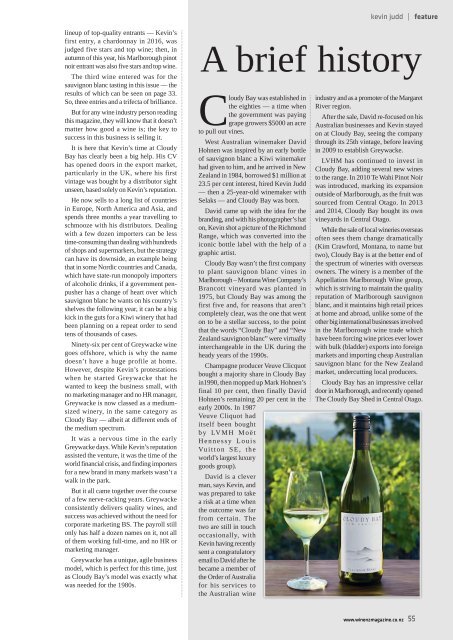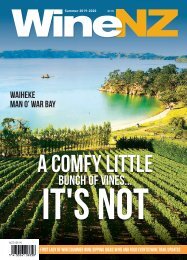WineNZ Summer 18-19 (1)
You also want an ePaper? Increase the reach of your titles
YUMPU automatically turns print PDFs into web optimized ePapers that Google loves.
kevin judd | feature<br />
lineup of top-quality entrants — Kevin’s<br />
first entry, a chardonnay in 2016, was<br />
judged five stars and top wine; then, in<br />
autumn of this year, his Marlborough pinot<br />
noir entrant was also five stars and top wine.<br />
The third wine entered was for the<br />
sauvignon blanc tasting in this issue — the<br />
results of which can be seen on page 33.<br />
So, three entries and a trifecta of brilliance.<br />
But for any wine industry person reading<br />
this magazine, they will know that it doesn’t<br />
matter how good a wine is; the key to<br />
success in this business is selling it.<br />
It is here that Kevin’s time at Cloudy<br />
Bay has clearly been a big help. His CV<br />
has opened doors in the export market,<br />
particularly in the UK, where his first<br />
vintage was bought by a distributor sight<br />
unseen, based solely on Kevin’s reputation.<br />
He now sells to a long list of countries<br />
in Europe, North America and Asia, and<br />
spends three months a year travelling to<br />
schmooze with his distributors. Dealing<br />
with a few dozen importers can be less<br />
time-consuming than dealing with hundreds<br />
of shops and supermarkers, but the strategy<br />
can have its downside, an example being<br />
that in some Nordic countries and Canada,<br />
which have state-run monopoly importers<br />
of alcoholic drinks, if a government penpusher<br />
has a change of heart over which<br />
sauvignon blanc he wants on his country’s<br />
shelves the following year, it can be a big<br />
kick in the guts for a Kiwi winery that had<br />
been planning on a repeat order to send<br />
tens of thousands of cases.<br />
Ninety-six per cent of Greywacke wine<br />
goes offshore, which is why the name<br />
doesn’t have a huge profile at home.<br />
However, despite Kevin’s protestations<br />
when he started Greywacke that he<br />
wanted to keep the business small, with<br />
no marketing manager and no HR manager,<br />
Greywacke is now classed as a mediumsized<br />
winery, in the same category as<br />
Cloudy Bay — albeit at different ends of<br />
the medium spectrum.<br />
It was a nervous time in the early<br />
Greywacke days. While Kevin’s reputation<br />
assisted the venture, it was the time of the<br />
world financial crisis, and finding importers<br />
for a new brand in many markets wasn’t a<br />
walk in the park.<br />
But it all came together over the course<br />
of a few nerve-racking years. Greywacke<br />
consistently delivers quality wines, and<br />
success was achieved without the need for<br />
corporate marketing BS. The payroll still<br />
only has half a dozen names on it, not all<br />
of them working full-time, and no HR or<br />
marketing manager.<br />
Greywacke has a unique, agile business<br />
model, which is perfect for this time, just<br />
as Cloudy Bay’s model was exactly what<br />
was needed for the <strong>19</strong>80s.<br />
A brief history<br />
Cloudy Bay was established in<br />
the eighties — a time when<br />
the government was paying<br />
grape growers $5000 an acre<br />
to pull out vines.<br />
West Australian winemaker David<br />
Hohnen was inspired by an early bottle<br />
of sauvignon blanc a Kiwi winemaker<br />
had given to him, and he arrived in New<br />
Zealand in <strong>19</strong>84, borrowed $1 million at<br />
23.5 per cent interest, hired Kevin Judd<br />
— then a 25-year-old winemaker with<br />
Selaks — and Cloudy Bay was born.<br />
David came up with the idea for the<br />
branding, and with his photographer’s hat<br />
on, Kevin shot a picture of the Richmond<br />
Range, which was converted into the<br />
iconic bottle label with the help of a<br />
graphic artist.<br />
Cloudy Bay wasn’t the first company<br />
to plant sauvignon blanc vines in<br />
Marlborough – Montana Wine Company’s<br />
Brancott vineyard was planted in<br />
<strong>19</strong>75, but Cloudy Bay was among the<br />
first five and, for reasons that aren’t<br />
completely clear, was the one that went<br />
on to be a stellar success, to the point<br />
that the words “Cloudy Bay” and “New<br />
Zealand sauvignon blanc” were virtually<br />
interchangeable in the UK during the<br />
heady years of the <strong>19</strong>90s.<br />
Champagne producer Veuve Clicquot<br />
bought a majority share in Cloudy Bay<br />
in<strong>19</strong>90, then mopped up Mark Hohnen’s<br />
final 10 per cent, then finally David<br />
Hohnen’s remaining 20 per cent in the<br />
early 2000s. In <strong>19</strong>87<br />
Veuve Cliquot had<br />
itself been bought<br />
by LVMH Moët<br />
Hennessy Louis<br />
Vuitton SE, the<br />
world’s largest luxury<br />
goods group).<br />
David is a clever<br />
man, says Kevin, and<br />
was prepared to take<br />
a risk at a time when<br />
the outcome was far<br />
from certain. The<br />
two are still in touch<br />
occasionally, with<br />
Kevin having recently<br />
sent a congratulatory<br />
email to David after he<br />
became a member of<br />
the Order of Australia<br />
for his services to<br />
the Australian wine<br />
industry and as a promoter of the Margaret<br />
River region.<br />
After the sale, David re-focused on his<br />
Australian businesses and Kevin stayed<br />
on at Cloudy Bay, seeing the company<br />
through its 25th vintage, before leaving<br />
in 2009 to establish Greywacke.<br />
LVHM has continued to invest in<br />
Cloudy Bay, adding several new wines<br />
to the range. In 2010 Te Wahi Pinot Noir<br />
was introduced, marking its expansion<br />
outside of Marlborough, as the fruit was<br />
sourced from Central Otago. In 2013<br />
and 2014, Cloudy Bay bought its own<br />
vineyards in Central Otago.<br />
While the sale of local wineries overseas<br />
often sees them change dramatically<br />
(Kim Crawford, Montana, to name but<br />
two), Cloudy Bay is at the better end of<br />
the spectrum of wineries with overseas<br />
owners. The winery is a member of the<br />
Appellation Marlborough Wine group,<br />
which is striving to maintain the quality<br />
reputation of Marlborough sauvignon<br />
blanc, and it maintains high retail prices<br />
at home and abroad, unlike some of the<br />
other big international businesses involved<br />
in the Marlborough wine trade which<br />
have been forcing wine prices ever lower<br />
with bulk (bladder) exports into foreign<br />
markets and importing cheap Australian<br />
sauvignon blanc for the New Zealand<br />
market, undercutting local producers.<br />
Cloudy Bay has an impressive cellar<br />
door in Marlborough, and recently opened<br />
The Cloudy Bay Shed in Central Otago.<br />
55<br />
www.winenzmagazine.co.nz 55













